Whether you’re a competition angler, a happy-go-lucky angler or a specimen angler, every day we fish, we are presented with the same set of questions - where, when, what and how - and each day these questions will have a different set of answers. Isaac Walton said “fishing is like mathematics, in that it can never be learned” and it is certainly the challenges that nature brings to our sport that keep me awake at night and send me back out there trying again tomorrow. Whether it’s from behind the wheel of my boat, from the river bank or fishing from the shore - I like angling’s problems.
Bass fishing offers the ultimate challenge for the UK saltwater angler and it’s not hard to see why... they’re cunning little critters that like to keep you on your toes! Some days they wham baits down like there’s no tomorrow. Some days they hit and stun the bait first, then come back for the main attack. Some days they swallow tail first, whilst on other days they hit head first and run turning the bait as they go before taking it properly. Where as many species will either feed or they won’t, the temperament, of how and when a bass feeds, is far and wide!
When I’m making up a bass rig, there are two important things I’m looking to gain:
1 - near perfect bait presentation to attract in the first instance
2 - correct hook choice for the circumstances I face (including how hard the bass are feeding) to get the best chance of a hook-up on that given day.
If conditions suit, or if the bass are feeding in such a manner that I can use circle hooks, then this would be my first choice. I like the super lightweight Sakuma 440 Circle hook. For much of my day to day bassing - boat and shore - I’m more than comfortable that any bait I present on a Sakuma Manta 540 or Manta Extra 545, will not only look good, but will penetrate well, as long as the fish are feeding reasonably confidently. And on tough days - those days when bass pick up, run with, but then continually drop baits, I feel confident that a Sakuma 535 treble will give me good bait presentation with the slightest resistance setting the treble quickly, usually in the roof of the bass’ mouth. With all that you’d think I’d have it covered, but do you know what? I still have days where I lose fish after fish. So what’s the solution? Use two hooks!
How do you present two hooks in one bait? The most tried and tested two hook rig has to be the Pennel. In fact, I reckon that it is the only good two hook rig on offer when you need to present two hooks in one bait. But when using live-baits, especially from a drifting boat, Pennel rigs don’t offer good bait presentation. A pennel rig, when using frisky live baits or fishing in strong tides, the top hook often has the tendency to slide, pulling the bait into a ‘U’ shape which is about as unnatural as you can get because the bait spins and dies quickly, so it defeats the object in the first place. So we’re back to square one again – just how can you present two hooks in a live-bait? I think I have found a solution...
For years I have been looking to find the perfect way to present two hooks in one live-bait and finally I think I’ve come up with something that works pretty well. Whilst fishing in Miami two years ago, I came across the Miami ‘Smoker’ Kingfish rig. The Smoker rig is a single hook, crimped to a wire leader and to the eye of this hook is crimped another short section of wire leader, to which a second hook, usually a treble, is added. As you would imagine, the first hook is placed in the snout/jaw of a baitfish and the second hook (the shorter flyer) is lodged somewhere in the dorsal of the baitfish, giving two chances of a hook-up on each positive take.
So a different rig, but the same problem – still no way to join the two hooks effectively. The Pennel has the tendency to slide, but the last thing you want to do is start crimping or knotting extra pieces of line, making the rig more complicated and visible, when in fact all that is needed is one good knot. Then it came to me... the Knotless knot for carp fishing!
The Knotless knot, aka the Hair rig, is used for presenting Boilies, on a length of line away from the hook, so I set about making my own two hook rig, inspired by all three rigs – the Miami Smoker, the Pennel and the Hair rig... and the result is the Stinger!
1. Firstly cut the correct length trace you require. I use Fluorocarbon traces usually 8-15ft in length. When you have done this, tie your chosen ‘Stinger’ treble on the end. My preference would be a Sakuma 535 joined using a tucked blood knot.
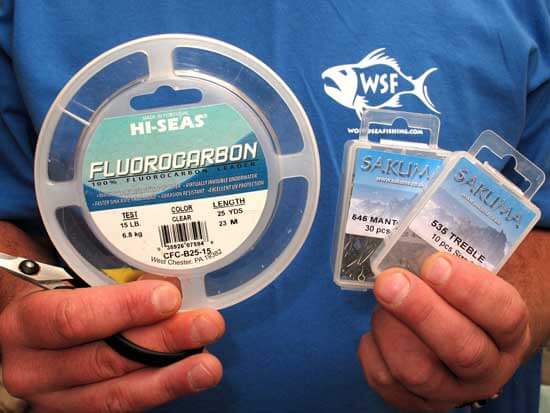
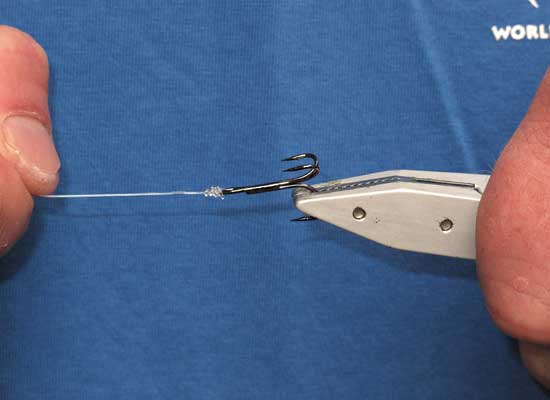
2. Next take your main Aberdeen or Circle hook and thread it down the trace until it reaches the treble, setting the required distance between the two hooks (which will depend on what bait you’re using). Keep the main hook inline, so that the ‘Stinging Tail’ runs parallel with the main hook shank.
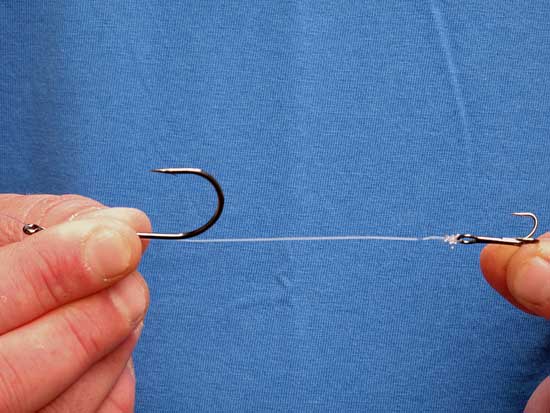
3. Now here comes the hard part... which is in fact incredibly easy! Take the working end (the one with no treble hook attached) and wind it down and around the shank of the main hook (as if you were snelling a hook) for about 15 turns/wraps.
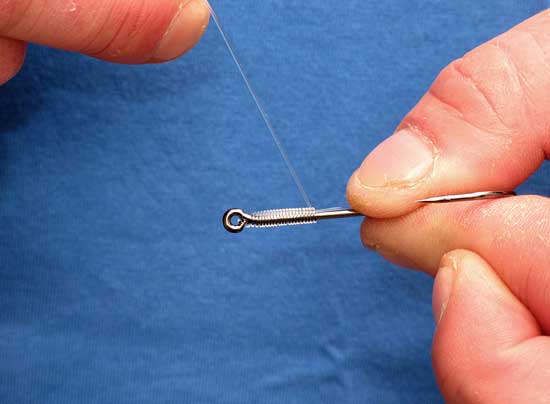
4. Finally when you’ve finished, take the line back up and through the eye of the hook again, but thread it through from the opposite way than you when you started in step two.
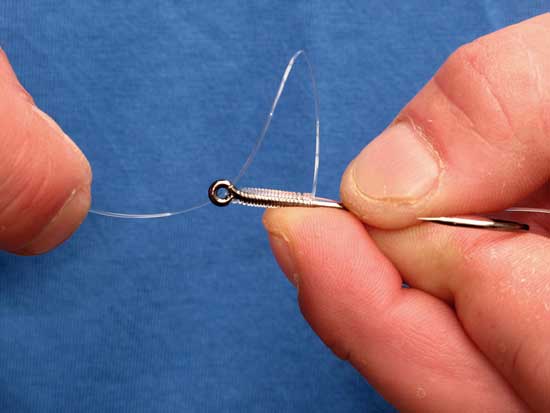
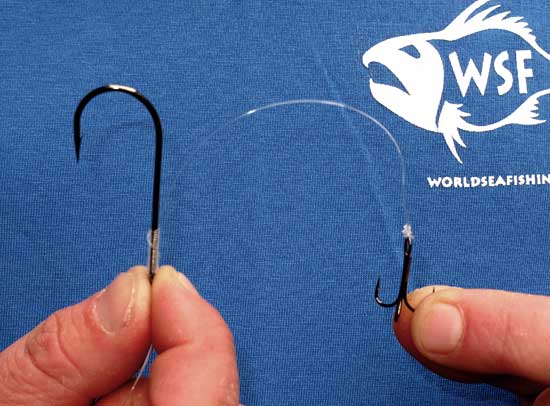
With the Knotless knot, the top hook cannot slide like a Pennel, therefore it presents live-baits more naturally, and having a treble for a second hook – a sting in the tail, hence the name Stinger – this rig offers increased chances of a hook-up on tough days! All you have to do now is tie the working end of the ‘Stinger’ trace onto your chosen rig. Mine would be a Portland rig or Portland float rig. I have yet to try this rig from the shore but I’m sure it would work well touch ledgering live-baits using a simple running rig.
If you want to be super-conservation minded, the barbs on the Treble stinger can be crushed using a pair of pliers. Or if you like, the rig can be fished with two Aberdeen’s (like a normal Pennel) or even two Circle hooks. Some of my favourite combinations include... A size 1/0 Sakuma 440 circle with a size 8 535 treble tied to 10lb fluorocarbon for live Sandeel. A size 4/0 Sakuma 540 Manta with a size 6 535 treble tied to 15lb fluorocarbon for live Launce. And finally a size 6/0 Sakuma 545 Manta Extra with a size 4 535 treble tied to 20lb fluorocarbon for live Mackerel and live Scad. I crush all the barbs on my trebles apart from the one, which I leave to hold the treble firmly in the dorsal of my live-bait.
Just last week I was lucky enough (or unlucky enough) to fish on one of those tough days, loosing bass after bass. After a tough morning, I switched to fishing a Joey mackerel on a size 4/0 Manta -size 4 treble Stinger rig and I was soon catching on those takes that would have otherwise been dropped.
The next time those bass aren’t hitting confidently, try rigging two hooks, ‘Stinger’ style, using the Knotless knot!
Bass fishing offers the ultimate challenge for the UK saltwater angler and it’s not hard to see why... they’re cunning little critters that like to keep you on your toes! Some days they wham baits down like there’s no tomorrow. Some days they hit and stun the bait first, then come back for the main attack. Some days they swallow tail first, whilst on other days they hit head first and run turning the bait as they go before taking it properly. Where as many species will either feed or they won’t, the temperament, of how and when a bass feeds, is far and wide!
When I’m making up a bass rig, there are two important things I’m looking to gain:
1 - near perfect bait presentation to attract in the first instance
2 - correct hook choice for the circumstances I face (including how hard the bass are feeding) to get the best chance of a hook-up on that given day.
If conditions suit, or if the bass are feeding in such a manner that I can use circle hooks, then this would be my first choice. I like the super lightweight Sakuma 440 Circle hook. For much of my day to day bassing - boat and shore - I’m more than comfortable that any bait I present on a Sakuma Manta 540 or Manta Extra 545, will not only look good, but will penetrate well, as long as the fish are feeding reasonably confidently. And on tough days - those days when bass pick up, run with, but then continually drop baits, I feel confident that a Sakuma 535 treble will give me good bait presentation with the slightest resistance setting the treble quickly, usually in the roof of the bass’ mouth. With all that you’d think I’d have it covered, but do you know what? I still have days where I lose fish after fish. So what’s the solution? Use two hooks!
How do you present two hooks in one bait? The most tried and tested two hook rig has to be the Pennel. In fact, I reckon that it is the only good two hook rig on offer when you need to present two hooks in one bait. But when using live-baits, especially from a drifting boat, Pennel rigs don’t offer good bait presentation. A pennel rig, when using frisky live baits or fishing in strong tides, the top hook often has the tendency to slide, pulling the bait into a ‘U’ shape which is about as unnatural as you can get because the bait spins and dies quickly, so it defeats the object in the first place. So we’re back to square one again – just how can you present two hooks in a live-bait? I think I have found a solution...
For years I have been looking to find the perfect way to present two hooks in one live-bait and finally I think I’ve come up with something that works pretty well. Whilst fishing in Miami two years ago, I came across the Miami ‘Smoker’ Kingfish rig. The Smoker rig is a single hook, crimped to a wire leader and to the eye of this hook is crimped another short section of wire leader, to which a second hook, usually a treble, is added. As you would imagine, the first hook is placed in the snout/jaw of a baitfish and the second hook (the shorter flyer) is lodged somewhere in the dorsal of the baitfish, giving two chances of a hook-up on each positive take.
So a different rig, but the same problem – still no way to join the two hooks effectively. The Pennel has the tendency to slide, but the last thing you want to do is start crimping or knotting extra pieces of line, making the rig more complicated and visible, when in fact all that is needed is one good knot. Then it came to me... the Knotless knot for carp fishing!
The Knotless knot, aka the Hair rig, is used for presenting Boilies, on a length of line away from the hook, so I set about making my own two hook rig, inspired by all three rigs – the Miami Smoker, the Pennel and the Hair rig... and the result is the Stinger!
1. Firstly cut the correct length trace you require. I use Fluorocarbon traces usually 8-15ft in length. When you have done this, tie your chosen ‘Stinger’ treble on the end. My preference would be a Sakuma 535 joined using a tucked blood knot.


2. Next take your main Aberdeen or Circle hook and thread it down the trace until it reaches the treble, setting the required distance between the two hooks (which will depend on what bait you’re using). Keep the main hook inline, so that the ‘Stinging Tail’ runs parallel with the main hook shank.

3. Now here comes the hard part... which is in fact incredibly easy! Take the working end (the one with no treble hook attached) and wind it down and around the shank of the main hook (as if you were snelling a hook) for about 15 turns/wraps.

4. Finally when you’ve finished, take the line back up and through the eye of the hook again, but thread it through from the opposite way than you when you started in step two.


With the Knotless knot, the top hook cannot slide like a Pennel, therefore it presents live-baits more naturally, and having a treble for a second hook – a sting in the tail, hence the name Stinger – this rig offers increased chances of a hook-up on tough days! All you have to do now is tie the working end of the ‘Stinger’ trace onto your chosen rig. Mine would be a Portland rig or Portland float rig. I have yet to try this rig from the shore but I’m sure it would work well touch ledgering live-baits using a simple running rig.
If you want to be super-conservation minded, the barbs on the Treble stinger can be crushed using a pair of pliers. Or if you like, the rig can be fished with two Aberdeen’s (like a normal Pennel) or even two Circle hooks. Some of my favourite combinations include... A size 1/0 Sakuma 440 circle with a size 8 535 treble tied to 10lb fluorocarbon for live Sandeel. A size 4/0 Sakuma 540 Manta with a size 6 535 treble tied to 15lb fluorocarbon for live Launce. And finally a size 6/0 Sakuma 545 Manta Extra with a size 4 535 treble tied to 20lb fluorocarbon for live Mackerel and live Scad. I crush all the barbs on my trebles apart from the one, which I leave to hold the treble firmly in the dorsal of my live-bait.
Just last week I was lucky enough (or unlucky enough) to fish on one of those tough days, loosing bass after bass. After a tough morning, I switched to fishing a Joey mackerel on a size 4/0 Manta -size 4 treble Stinger rig and I was soon catching on those takes that would have otherwise been dropped.
The next time those bass aren’t hitting confidently, try rigging two hooks, ‘Stinger’ style, using the Knotless knot!
